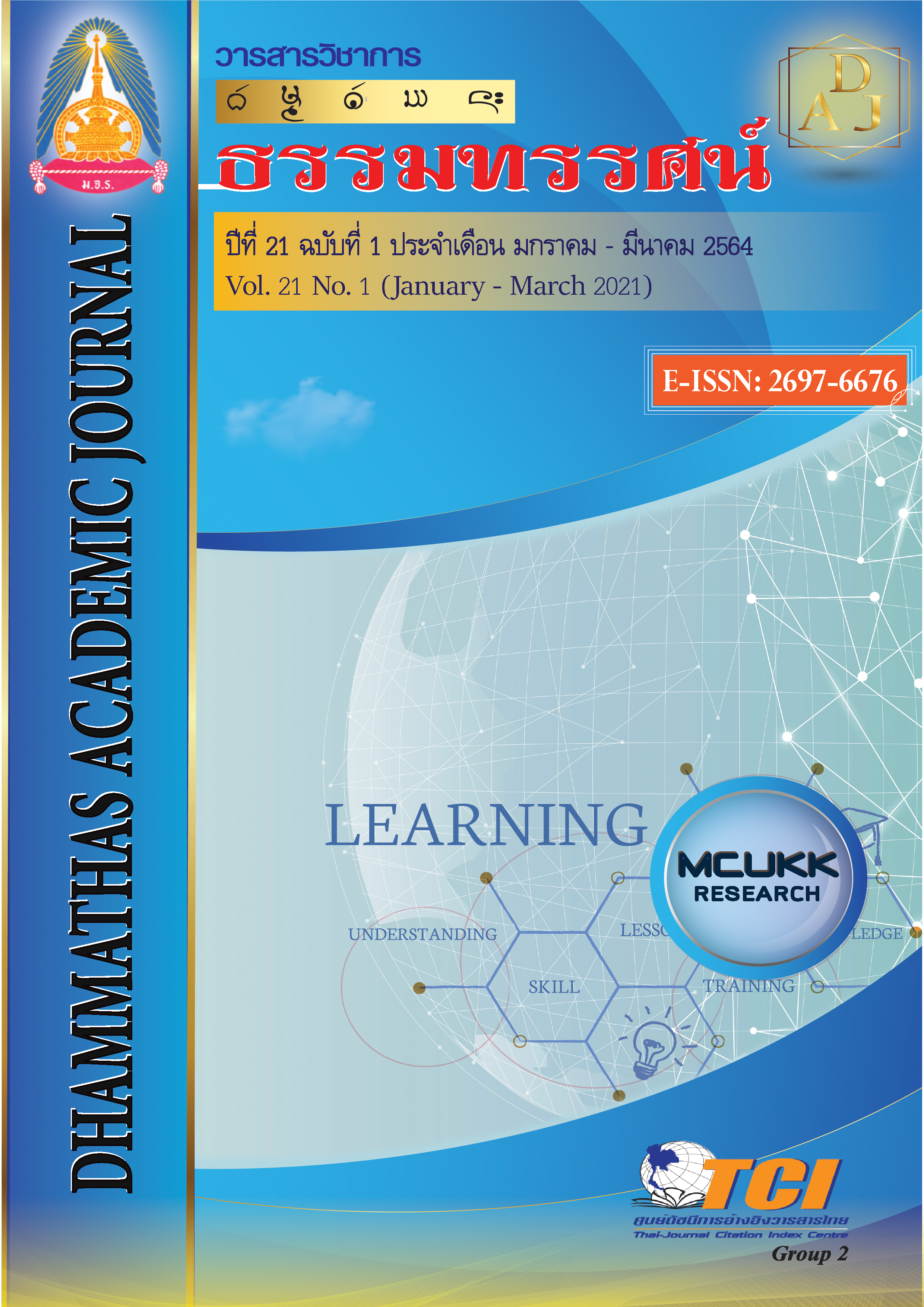Management Model of the Dual Vocational Education System at the Bachelor’s Degree in Technology or Operational Stream of Vocational Education Institutes
Main Article Content
Abstract
This research aimed at studying factors, creating, and evaluating the management model of the dual vocational education system at the bachelor’s degree of the vocational education institutes. This research method was in a mixed model comprised 3 stages. Stage 1 was to study about management by interviewing 25 experts. The research instrument was the interview. The statistics employed were frequency and percentage. Stage 2 was to create the management. The research instrument was the outline of management model of the dual vocational education system at the bachelor’s degree of the vocational education institutes and the seminar document references to 11 experts. The statistics used was content analysis. Stage 3 was to evaluate the management from 9 institutes, 63 participants. The statistics employed were mean and standard deviation.
The findings revealed as follows:
1. 9 factors of management model consisting of 1) students, 2) personnel, 3) budget, 4) curriculum, 5) supports for learning and instruction, 6) entrepreneurs’ establishments, 7) cooperation, 8) management process, and 9) graduates’ quality.
2. The management model can be concluded as follows: 1) It comprises 3 parts consisting of the following: Part 1 Introduction with objectives of the management model of the dual vocational education system at the bachelor’s degree level of the vocational education institutes. Part 2 Content consisting of (1) input, (2) processes, and (3) feedback. Part 3 Conditions for success. 2) Confirmatory result of the management model according to the experts’ opinions as a whole was accuracy and suitability. 3) Evaluation of the handbook for the management model found that the handbook was accuracy and suitability at a high level.
3. The evaluation of the management model as a whole was at the highest level. When considered aspect by aspect, the highest average of evaluation was the aspect of utility was at the highest level, whereas the lowest average of evaluation was the aspect of feasibility was at the highest level.
Article Details
References
เกรียงศักดิ์ เจริญวงศ์ศักดิ์. (2548). วิจัยทัศน์การอาชีวศึกษา. เข้าถึงได้จาก http://www.kriengsak.com/node/924
คัมภีร์ สุดแท้. (2553). การพัฒนารูปแบบการบริหารงานวิชาการสําหรับโรงเรียนขนาดเล็ก. (วิทยานิพนธ์ครุศาสตรดุษฎีบัณฑิต). มหาสารคาม: มหาวิทยาลัยราชภัฏมหาสารคาม.
จักรพันธุ์ ปัญจสุวรรณ. (2547). แนวทางการแก้ปัญหาการจัดการอาชีวศึกษาทวิภาคีของวิทยาลัยอาชีวศึกษาในสังกัดสำนักงานคณะกรรมการการอาชีวศึกษาอย่างเป็นระบบ. กรุงเทพฯ: มหาวิทยาลัยเกษตรศาสตร์.
จิดาภา ถิระศิริกุล. (2559). การจัดการศึกษาอาชีวศึกษาระบบทวิภาคีในประเทศต่างๆ: คุณลักษณะร่วมและปัจจัยแห่งความสำเร็จ. วารสารวิชาการสมาคมสถาบันอุดมศึกษาเอกชนแห่งประเทศไทย, 22(1), 51-60.
ชูเวช ชาญสง่าเวช. (2542). การจัดอันดับมหาวิทยาลัยในต่างประเทศ: แนวทางสำหรับประเทศไทย. กรุงเทพฯ: สำนักงานคณะกรรมการการศึกษาแห่งชาติ.
ทิฐินันท์ ทุมมา. (2556). รูปแบบการจัดการอาชีวศึกษาระดับเทคโนโลยีบัณฑิต โดยความร่วมมือระหว่างสถาบันการอาชีวศึกษากับสถานประกอบการ เพื่อพัฒนาคุณลักษณะของบัณฑิตตามมาตรฐานอาชีวศึกษา. (วิทยานิพนธ์ศึกษาศาสตรมหาบัณฑิต). กรุงเทพฯ: มหาวิทยาลัยอีสเทิร์นเอเชีย.
ธวัช เติมญวณ. (2548). การพัฒนารูปแบบการเรียนการสอนที่มีประสิทธิผลสำหรับหลักสูตรปริญญาตรีในสถาบันอุดมศึกษาในสังกัดกรมศิลปากร. กรุงเทพฯ: มหาวิทยาลัยศรีนครินทรวิโรฒ.
ธานินทร์ ศรีชมภู. (2557). การพัฒนารูปแบบการบริหารงานอาชีวศึกษาระบบทวิภาคีในสถานศึกษา สังกัดสำนักงานคณะกรรมการการอาชีวศึกษา. (วิทยานิพนธ์ครุศาสตรดุษฎีบัณฑิต). พิษณุโลก: มหาวิทยาลัยนเรศวร.
ธีรวุธ ชมใจ. (2554). การพัฒนารูปแบบความร่วมมือระบบอาชีวศึกษาไตรภาคี. กรุงเทพฯ: มหาวิทยาลัยศรีนครินทรวิโรฒ.
นวพร ถิ่นไทรงาม. (2543). รูปแบบความร่วมมือระหว่างสถานศึกษาและสถานประกอบการในการฝึกทักษะวิชาชีพปริญญาตรี-การพัฒนาผลิตภัณฑ์อาหารและโภชนาการ. กรุงเทพฯ: สถาบันเทคโนโลยีพระจอมเกล้าพระนครเหนือ.
ประทุม วิเชียรรัตน์. (2547). ประสิทธิผลการปฏิรูปการเรียนรู้ของสถานศึกษา สังกัดสำนักงานคณะกรรมการการอาชีวศึกษา กรุงเทพมหานคร. กรุงเทพฯ: สถาบันเทคโนโลยีพระจอมเกล้าเจ้าคุณทหารลาดกระบัง.
เพ็ชรี รูปะวิเชตร์. (2547). สภาพการฝึกประสบการณ์วิชาชีพครูของนักศึกษาสาขาวิชาบริหารธุรกิจ ภาควิชาอาชีวศึกษา คณะศึกษาศาสตร์ มหาวิทยาลัยเชียงใหม่ ประจำปีการศึกษา 1/2546. เชียงใหม่: มหาวิทยาลัยเชียงใหม่.
ไพฑูรย์ สินลารัตน์. (2523). ปรัชญาการศึกษาและปรัชญาการศึกษาของไทย. กรุงเทพฯ: ไทยวัฒนาพานิช.
สมภพ สุวรรณรัฐ. (2545). การพัฒนารูปแบบการจัดอาชีวศึกษาทางไกลในทศวรรษหน้าของประเทศไทย. กรุงเทพฯ: มหาวิทยาลัยเกษตรศาสตร์.
สำนักงานเลขาธิการสภาการศึกษา. (2551). การจัดการเรียนรู้ที่ส่งเสริมคุณธรรม. กรุงเทพฯ: สำนักงานเลขาธิการสภาการศึกษา.
________. (2552). ขอเสนอการปฏิรูปการศึกษาในทศวรรษที่สอง (พ.ศ. 2552-2561). กรุงเทพฯ: บริษัท พริกหวานกราฟฟิค จำกัด.
หาญยงค์ หอสุขศิริ. (2546). แนวโน้มการอาชีวศึกษาระดับอุดมศึกษาต่ำกว่าปริญญา ประเภทวิชาช่างอุตสาหกรรมในทศวรรษหน้า. (วิทยานิพนธ์ครุศาสตรอุตสาหกรรมมหาบัณฑิต). กรุงเทพฯ: สถาบันเทคโนโลยีพระจอมเกล้าเจ้าคุณทหารลาดกระบัง.
อนันต์ งามสะอาด. (2549). การจัดการศึกษาอาชีวศึกษาระบบทวีภาคีด้วยหลักการมีส่วนร่วม: กรณีวิทยาลัยเทคนิคเดชอุดม. (วิทยานิพนธ์ศึกษาศาสตรดุษฎีบัณฑิต). ขอนแก่น: มหาวิทยาลัยขอนแก่น.
อุทัย บุญประเสริฐ. (2553). การศึกษาการบริหารและการจัดการศึกษาในโรงเรียนในรูปแบบการบริหารโดยใช้โรงเรียนเป็นฐาน. กรุงเทพฯ: คุรุสภาลาดพร้าว.
Carnoy, Martin. (1999). Globalization and education reform: what planners need to know. Paris: UNESCO.
Malhotra, Y. (1996). Organizational Learning and Learning Organizations: An Overview. Retrieved from http://www.brint.com/papers/orglrng.htm

